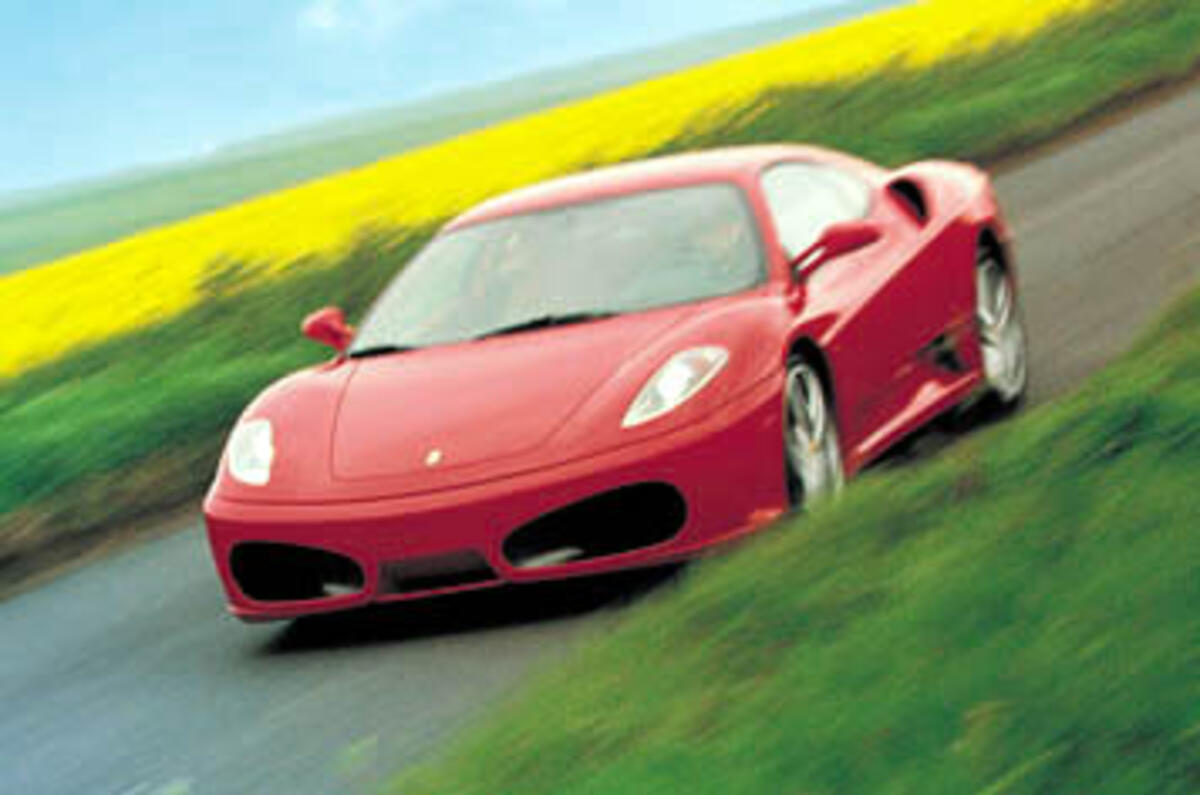No matter how much Ferrari tries to sanitise and inject comfort into its road cars, there is one aspect of its products that endless track sessions and computer-aided design will never be able to weed out. The sudden emergence of rank immaturity the moment an adult is handed the keys to a Rosso Corsa Ferrari.So, after my first 20 minutes in an F430, I stop and consider what it is I’ve learnt about a car that I’m led to believe takes the best aspects of the old 360 and adds enough cor blimey to make it the best sports car on sale.Well, for starters it’s appallingly jerky in traffic. I mean, every time I try to steer a sensible 15mph through the Brighton traffic, for some reason the car slows down to create a 50-yard gap to the next car and promptly erupts in first gear. Then again, this might have something to do with me coasting to create some space, then pinning the throttle and becoming addicted to the moment that 4308cc V8’s exhaust stops gurgling and begins to howl.And the heater’s rubbish. Here I am on Blighty’s foremost seaside promenade, the left-hand side of my face slowly going numb and erupting in goose-bumps. But perhaps, on reflection, not having the driver’s side window down at all times would sort this problem fairly quickly. Come to think of it, turning the heater on might provide a fairer assessment of its warming capabilities. Actually, locating its whereabouts would be a start. Likewise the stereo. Ditto everything else about the 430 that doesn’t involve driving, window-lowered, and listening to its tune. The lucky few owners of this car will take at least three months to break through the immaturity process and discover the car underneath. If it were mine, I’m not sure I ever would. Crikey, would that make me one of the yo-yoing poseurs on the King’s Road?Above all else, Ferrari is rigidly faithful to its historical roots, and that includes repeating events. What it has achieved with the transition from 360 to 430 is a replica of events nearly 10 years ago. Stung by criticism of the 348, it countered with the sublime 355. And whereas the 360 will never be considered anything like as much of a hound as the 348, it was never quite the object we’d hoped: too spikey on the limit, lacking beauty in its details.How does it look?In the raw, in England, in red, the 430 is a stunner. Still not beautiful in the way a 308 or a 355 remain objects of delicate fascination, but a car to stop the traffic wherever you go. Criticisms? It sits a bit high at the rear, and the 430 logos on the wing mirrors have a whiff of chav about them, but otherwise I’m taken with it.But for all the styling, it’s the engine I’ve been waiting to see and experience. Am I the only one left speechless by the fact that the smallest Ferrari now has 483bhp? In 1989 the fastest road car in the world was made by the same company; it was called the F40, and it had 478bhp. Okay, at 1100kg it boasted a power-to-weight ratio well beyond the 430’s 333bhp per tonne, but the numbers churned out by this entry-level car are enough to make you question where Ferrari can go from here. Somehow it has managed to squeeze 116bhp per litre from a 4308cc V8 (the flat-plane crank and some trick variable valve timing allow it to rev like very few other large capacity motors can) and a respectable 343lb ft of torque.And despite possessing the top-end sting of a box jellyfish, the 430’s motor is a delight in town. In fact, the whole car is so much more comfortable just plodding about that current 360 owners will be amazed. This is partly due to the engine, but mostly it’s down to the revised F1 transmission. I think, and I’m writing this through a gritted keyboard, that this might be the first paddle-shift gearchange to have instead of a manual. Not once in a dozen awkward three-pointers and other assorted manoeuvres did reverse refuse to engage, the clutch bite too early or begin to smell like a delinquent GCSE chemistry class, nor did it dish out any of the other perpetual nightmares Ferrari F1 consumers have suffered since the system’s introduction in ’97. I can now execute a hurried three-point turn with a paddle-shift as quickly as I can with a stick-shift. And I never thought that would happen.Noise, power, funFor all the numbers, I’ve always been a little suspicious of Ferrari’s claimed outputs from these high-revving V8s. Yes, the 360 was quick, and yet with 276bhp per tonne it should have been quicker still, but the clever exhaust made such wonderful noises that most people felt like they were travelling at warp nine when warp seven-and-a-bit was probably closer to the truth.At first you think the same is true of the 430. Everything is dominated by the noise. Common sense means the windows are now closed, but still the sensation is of sitting in front of an agitated rodeo stallion that’s been bolted in behind the rear firewall, as it snorts, gasps and yelps, rather than having an inorganic piece of machinery propelling you. Once again the noise heightens the sense of speed, but just as you begin to assume the same process of artificial amplification might be at work, you look at the speedo and realise the truth. It’s mighty fast. We’ll have to wait until the chance to figure the car arrives, but a mid-eight second to 100mph time should be on the cards and that puts it comfortably ahead of the Lamborghini Gallardo, even if that has a much stronger mid-range.Again, the transmission plays a key role. Historically, so much of accessing a Ferrari’s straight-line potential has been about concentrating enough to shove the gear lever about with speed and accuracy. Now that’s no longer necessary the driver has more time to absorb and observe everything else. The way the 430 will action a flat-shift from first to second in race mode (the fastest of the gearbox settings) is, on its own, almost a justification for the entire F1 programme. Whereas under the same circumstances BMW’s SMG ’box in the M6 has you waiting for a gear cog to come spinning through the rear seats, the 430’s hips proffer the faintest of wiggles and the motor nearly overwhelms the limiter in second gear as you take in the devastating speed and smoothness of the change.And race mode? The 430’s electronic differential had already been well-chronicled in these pages, but will it prove to be the automotive gizmo of 2005 or will the M5 and M6’s power button just nip in front? I’m with Ferrari’s E-differential on this one. With five settings (snowy, slippy, sporty, race and disengage) it might just be the single greatest advance in traction control technology ever seen in a road car. Rather than brake individual rear wheels to control slip, each driveshaft has its own clutch whose lock-up is varied according to the selected setting. What this means is that rather than killing a slide with a combination of braking and removing the throttle, the 430 will keep the power on and regulate the slide. I reckon an infant of marginal talent could drift a 430 safely given the correct E-diff setting.It certainly doesn’t feel like a 1450kg car. That’s partly because the steering has been so well judged for speed, but in the main it’s the Skyhook damping that helps hide the weight. Rigid control is available at all times, but it’s supple and Lotus-like over most surfaces. In fact, over the majority of UK roads this car just feels like a 483bhp Lotus Exige, and I can’t think of a greater compliment than that. You can place it accurately, the Bridgestone RE050s have enough grip to make unsticking the front end on the public road a silly occupation and, this being the baby Ferrari, it’s just about wieldy enough not to worry about clouting oncoming traffic – although it’s gained some girth over the 360 around the hips.From the insideWhat a cabin. Ferrari’s front-engined Berlinettas have always benefited from far more sumptuous and attractive interiors than its mid-engined cars, but the 430 bucks that trend. I don’t know whether it’s the Enzo-style instrument cowling or the delectable wheel complete with E-diff settings that gets me most excitable, but this is just one of the great cars to sit in. They’ve achieved a great balance of techno-trickery and appropriate sparseness. Needless to say, the driving position is absolutely spot-on, the seats are beyond reproach and the wheel would be worthy of a design medal if someone hadn’t put the horn buttons right where your thumbs naturally sit when you’re tanking on. Oh, and the heater’s a scorcher and the hi-fi is serviceable. Just.Along with inadvertently beeping at all other road users, potential owners will also become acquainted with the car’s lack of front ground clearance on our choppier roads. The 430 will kiss the ground with its chin well before any of the suspension components have given any indication that they’re working towards the extremes of their abilities. Even with the standard steel brakes, stopping power is all you’ll ever need on the road although track-day types will doubtless opt for the pricey ceramic replacements.Finding a 430 won’t be easy. The waiting list stretches well into the back end of next year and there are already early right-hand-drive cars around at silly money. But it is a corking car, and one that stays true to Ferrari’s philosophy at a time when it might have wavered. It’s difficult to see how they could have made it much better or desirable in a single key area, and that’s some achievement.Chris Harris
From £178,491
England expects
Close
Back to top





















Add your comment